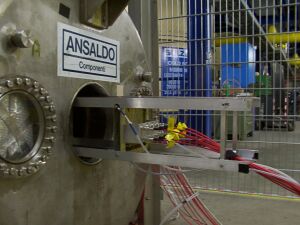URL: https://www.desy.de/news/news/archive_before_2010/2003/ilc_0502/index_eng.html
Breadcrumb Navigation
Research and Development for the TESLA Detector
The R & D work for the TESLA detector made an important step forward: an international team started a successful test series towards one of the detector components, the so-called time projection chamber (TPC). The strong magnetic field needed for this purpose is produced by a superconducting magnet.

The superconducting magnet with a time projection chamber, used for test measurements.
In the course of the HERA upgrade, this magnet was removed from the ZEUS experiment and re-commissioned for its new task in the cryogenic hall. Liquid Helium supply lines had to be installed, and the magnet's instrumentation was integrated into the cryogenic control system. After completion, the magnet was cooled down to ist operation temperature of minus 269 degrees Celsius at first go. With a current of 1000 Amperes it subsequently reached a magnetic field strength of 5.25 Tesla, and measurements at a test TPC could start. The time projection chamber is used to measure tracks produced by electrically charged particles. The chamber is immersed in a strong magnetic field in order to determine the momentum of the particles. Here, the focus is on an operational test of the readout via so-called Gas Electron Multipliers, GEMs. The GEM technology offers very good position resolution of the particle tracks, however, it is not yet fully developed for the magnetic field strength of 4 Tesla, envisaged for the TESLA detector. In the coming months, scientists from several institutes participating in the international linear collider TPC group will install their test chambers in the superconducting magnet for further measurements.


